
Back تجدد العظام Arabic Remodelació òssia Catalan Knochenumbau German Rimodellamento osseo Italian Remodelação óssea Portuguese Modelacija i remodelacija kosti Serbian என்பு மீள் வடிவமைப்பு Tamil

In osteology, bone remodeling or bone metabolism is a lifelong process where mature bone tissue is removed from the skeleton (a process called bone resorption) and new bone tissue is formed (a process called ossification or new bone formation). These processes also control the reshaping or replacement of bone following injuries like fractures but also micro-damage, which occurs during normal activity. Remodeling responds also to functional demands of the mechanical loading.
In the first year of life, almost 100% of the skeleton is replaced. In adults, remodeling proceeds at about 10% per year.[1]
An imbalance in the regulation of bone remodeling's two sub-processes, bone resorption and bone formation, results in many metabolic bone diseases, such as osteoporosis.[2]
© MMXXIII Rich X Search. We shall prevail. All rights reserved. Rich X Search